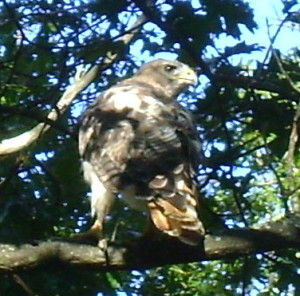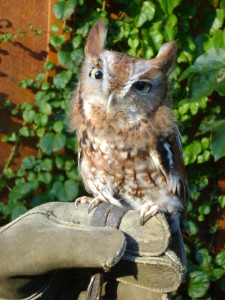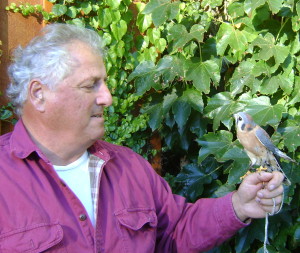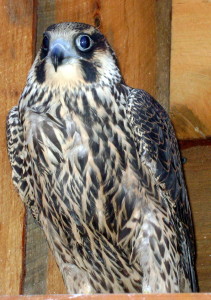Raptor Rapture
The pickup truck rolled to a stop by a gate that blocked vehicles from the entrance to Grills Preserve in Westerly. It was afternoon in early autumn, and though it was not yet five o’clock, the shadows had begun to lengthen. John and Vivian Maxson, the team that comprised Born to be Wild Nature Center (BTBW), climbed out of the truck. John reached into the truck bed and grabbed a white box bound with string, and the couple began to walk into the woods. The contents of the box suddenly began to bounce around, despite the care with which John carried it. The bouncing came from the inside.
“There are some good branches here,” Vivian said as the couple strolled deeper into the woods. The spot was off the remains of a side road, more open than other sections, with oak branches reaching out at around thirty feet from the ground. John stopped and placed the rectangular white box, long side up, on a downed tree. Vivian moved back a dozen feet. John opened a door on the side of the box: there was a large, dark shape inside. A second later, a female red-tailed hawk burst from the box, its two-foot wingspan vividly apparent at this low height as it quickly ascended to the welcoming arms of a nearby oak. “Nice up!” Vivian exclaimed, enthusiastic about the rise from the ground to the branch. It’s a sign that things look good for the hawk, after spending days in the care of Born to be Wild Nature Center. This is what it means to be a raptor rehabilitator.
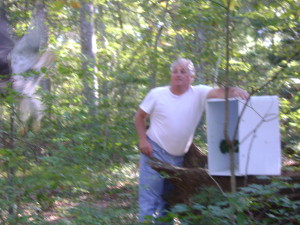
In this blurry shot, a red-tailed hawk bursts free from its transport box as raptor rehabilitator John Maxson looks on.
In 1998, the Maxsons decided to take a course to become certified as wildlife rehabilitators. Though the course was brief, participants were required to do a year-long apprenticeship with an experienced rehabilitator before being licensed. Vivian explained how the team came to specialize in the animals they do: “At first, we used to take care of small mammals, like squirrels, and there were also lots of people who would specialize in songbird care. But we noticed that there was really no one who specialized in caring for raptors.” Raptors, which include hawks, owls, and kestrels, are birds of prey known for using their sharp, powerful talons to grasp and kill their food. They are federally protected birds, and even possessing one of their feathers can land a person a hefty fine. “These birds are just so beautiful,” said Vivian.
The red-tail had been brought to The Wildlife Clinic of Rhode Island after being hit by a car. “It was doing better, but it wasn’t self-feeding,” she explains. “Also there was a concern because it was doing what’s called ‘star gazing.’ That’s when the bird repeatedly turns its head up to the skies for no reason. It’s an indication of neurological damage.” A bird that can’t feed itself will starve quickly. For the Maxsons, that meant they had to spend several days cutting frozen mice into small, “bite-sized” pieces and offering it to the hawk by hand. (Frozen mice are purchased by pet owners and scientists.) The hawk, estimated by Vivian to be roughly one and one-half to two years old, gradually stopped star-gazing and began to resume self feeding. That’s when they knew it was time to restore the animal to the wild.
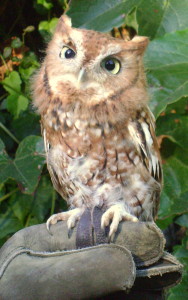 After becoming certified as rehabilitators, the couple built a cage at their Bradford home, and BTBW grew from there. Currently, their headquarters includes several such structures, including a massive new flight rehabilitation cage measuring some twelve feet high and forty feet in length. All of them have been built by John Maxson, with help from carpenters and the occasional volunteer. Inside the largest cage, there are “handicap ladders” that extend from the ground to perches and platforms eight feet above the ground. The ladders are made of rough lengths of branch and steps intended to resemble the natural tree branches on which the raptors would feel at home. John explains: “When the birds come to us, they may not be able to fly to their perches. Having a ladder gives them a chance to get to a spot where they feel secure, even if they can’t fly to it.” John, a special education teacher in Westerly, entered the cage of a peregrine falcon and began to speak quietly to it while Vivian discussed life as a rehabilitator.
After becoming certified as rehabilitators, the couple built a cage at their Bradford home, and BTBW grew from there. Currently, their headquarters includes several such structures, including a massive new flight rehabilitation cage measuring some twelve feet high and forty feet in length. All of them have been built by John Maxson, with help from carpenters and the occasional volunteer. Inside the largest cage, there are “handicap ladders” that extend from the ground to perches and platforms eight feet above the ground. The ladders are made of rough lengths of branch and steps intended to resemble the natural tree branches on which the raptors would feel at home. John explains: “When the birds come to us, they may not be able to fly to their perches. Having a ladder gives them a chance to get to a spot where they feel secure, even if they can’t fly to it.” John, a special education teacher in Westerly, entered the cage of a peregrine falcon and began to speak quietly to it while Vivian discussed life as a rehabilitator.
“It’s just such a good feeling to be able to help out an animal like that,” Maxson says. BTBW is currently home to ten birds, and it takes care of roughly sixty in the course of a year. Four are residents of the center; those whose injuries were too severe for them to be released into the wild. These animals become the mainstays of BTBW’s education programs. The Maxsons and their birds visit schools, summer camps, and festivals to educate the public about the importance of preserving these creatures and their habitat. These visits have the reciprocal effect of providing BTBW with the resources to carry on its work.
“We don’t receive any grants or funding of any kind,” John says. “This operation is based only on donations for public appearances and private individuals who appreciate what we do.” Locating and maintaining funding is a constant chore. BTBW’s website, www.hawkri.org, contains information about what the center does, visitor information, and a modest “donate” button for those who wish to support.
Recently, the Maxsons began to invite groups to their Center for on-site bird talks. “We’d like to have this become a permanent destination. This summer was the first time we brought in several groups: a group of home schoolers and some summer camps.” “It was just wonderful!” Vivian exclaims. “One of the best things is the people that you meet in this business. We really like the people we’ve met!”
To say John and Vivian Maxson are passionate about their mission would be an understatement. Sitting under a grape arbor after the hawk release, John surveys the cages scattered across the center. “They’ll probably scatter my ashes out here,” he jokes. “As long as we have the spirit and the gumption, we’ll keep going.”
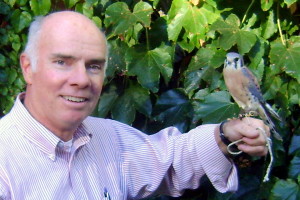
The author gets the amazing experience of holding Teo, thereby showing one of the coolest parts of writing these stories: posing with critters.
Hugh Markey is a freelance writer, naturalist, and teacher who lives in Richmond, and who puts out a new blog post almost every week. Come back soon!

